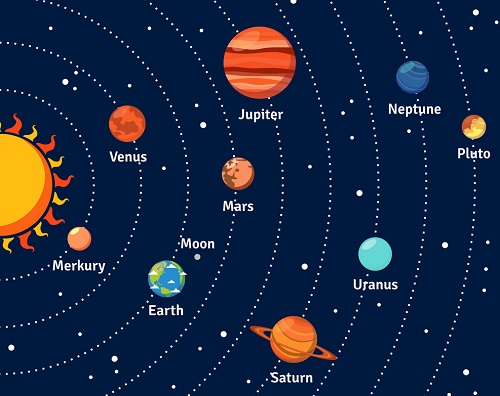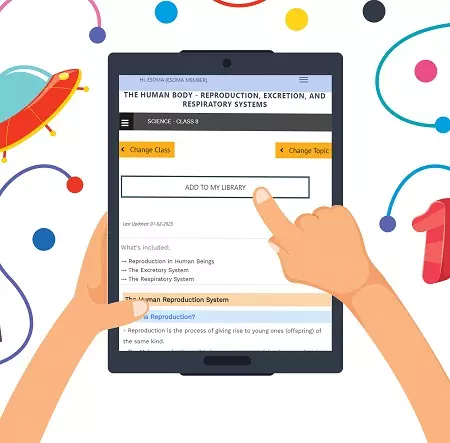The Sun
It's the centre of the universe.
Characteristics of the Sun
- It is a star
A
star is a heavenly possessing its own light which it transmits.
Nebula/galaxy is a cluster of stars. The earth is in a galaxy called
The Milky Way.
- It's made of very hot gases mainly hydrogen (70%) and helium (30%).
- Has a diameter of 1392000km.
- Surrounded by a layer of gas which has boiled from its surface which is called corona.
- Rotates on its own axis in anticlockwise direction.
- Has gravitational pull which holds all the planets in
orbit around it.
[Definition: An
orbit is a path which a planet or a satellite follows around a star or a planet.]
- Temperature at its centre is 15m◦c and at the surface is 5500°c.
- Radiates solar energy which is very important for all forms of life on the earth.

[
The Sun]
The Planets
- Planets are large spherical celestial/heavenly bodies in space.
- There are 9 planets in our solar system.
Characteristics of Planets
- Spherical in shape
- Don't have their own light but reflect it from the sun.
- Revolve around the sun in anticlockwise direction.
- Have their own force of gravity
- Only one is known to support life.

[
The Planets in the Orbits]
1. Mercury
- Nearest from the sun
- It's 58 million km from the sun
- Has no satellites
- Takes approximately 88 earth days to revolve around the sun
2. Venus
- 2nd planet from the sun
- It's 108 million km from the sun
- One of the brightest planets
- Can be seen clearly with naked eyes
- Takes approximately 225 earth days to revolve around the sun
- Slightly smaller than the earth
- Has no satellites
- Together with the earth they are called twin planets due to having many similarities
3. Earth
- The 3rd planet from the sun Earth
- The earth and the heavenly bodies make the universe
- The only planet that supports life
- The home of man
- Approximately 149 million km from the sun
- Takes 365 and a quarter days to revolve around the sun
- Has one satellite, the moon
4. Mars
- Also called The Red Planet because when it's observed through a telescope it appears reddish.
- The 4th from the sun
- Slightly smaller than the earth
- Approximately 228 million km from the sun
- Takes 687 earth days to revolve around the sun
- Between Mass and Jupiter there are small celestial bodies called planetoids.
- Has no satellite.
5. Jupiter
- 5th planet from the sun
- Approximately 778 million km from the sun
- Largest in the universe
- Rotates on its own axis at very fast speed
- Has flattened poles due to its fast speed of rotation
- Has very thick layers of ice on its surface
- takes 12 earth years to revolve around the sun
- Has 16 satellites
6. Saturn
- 6th planet from the sun
- Second largest planet
- Approximately 1427 million km from the sun
- Takes 29.5 earth years to revolve around the sun
- Has a ring around it
- Has 18 satellites
7. Uranus
- 7th planet from the sun
- About 4 times bigger than the earth
- Approximately 2870 million km from the sun
- Also rotates very fast
- Also has flattened poles due to fast speed of rotation
- It appears greenish foe being surrounded by methane gas
- Has 8 satellites
- Takes 84 earth years to revolve around the sun
8. Neptune
- One of the farthest from the sun
- 8th planet from the sun
- Approximately 4497 million km from the sun
- Has 8 satellites
- Takes 165 earth years to revolve around the sun
- Very similar in size, colour and character with Uranus
9. Pluto
- 9th planet from the earth
- Farthest from the sun
- The smallest
- 1/6 (Sixth) the size of the earth
- Approximately 5900 million km from the sun
- Takes 248 earth years to revolve around the sun
- Has one satellite
- Very little is known about it
Please note that some materials might state that we have 8 planets. In 2006, Pluto was downgraded from a full-size planet to a dwarf planet. It was discovered in 1930. in addition, did you
know the Pluto was name suggested by an 11 years old, Venetia Burney? Well, that is true!
Other Celestial Bodies
Natural Satellites
- Any natural heavenly body that orbits around a planet e.g. moon for earth, Titan for Saturn and Triton for Neptune.
Asteroids/Planetoids
- Also called minor planets.
- Are small fragments of rocks left going around the sun when the solar system was formed
- Found between Mass and Jupiter
- Are 1500 in number
- They sometimes collide with each other and planets due to Jupiter's gravitational pull causing them to move in erratic orbits.
Comets
- Heavenly bodies which appear to have a head and a long tail
- Made of ice, dust and frozen gas
- The head is made of many particles of dust, rock and frozen gases.
- Their tail is made of gases and points away from the sun.
- Move around the sun in extremely long and oval orbits
- Their orbits cross the earth’s orbits e.g. Haley's comet which appears after every 76 years.
Meteoroid
- Small heavenly body which strays from its orbit in the solar system and enters the earth’s atmosphere at very high speed.
Meteor
- A meteoroid which is burning out due to friction after entering the earth's atmosphere



